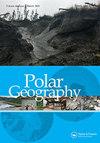“有新物种”:北极雅库特生物多样性变化的本土知识
IF 1.6
Q3 GEOGRAPHY, PHYSICAL
引用次数: 15
摘要
气候变化、营养物污染、土地转化、过度开发、入侵物种和疾病——全球生态系统变化的“五大”驱动因素——正在改变北极的生物多样性。生物多样性的变化对当地人有影响,因为他们的传统活动依赖生物多样性。北极偏远地区缺乏生物多样性状况和趋势的科学记录。本土知识可以帮助填补这些信息空白。更重要的是,知识对于建立生物多样性保护和可持续利用的政策和实践至关重要。本研究呈现俄罗斯东北西伯利亚北极雅库特地区原住民对生物多样性变化及趋势的认知。研究结果记录了土著居民对研究地点生物多样性变化的看法:动植物新物种的分布范围向北扩展,土著物种的丰富度和植物的物候发生了变化。IK将这些趋势与不同的全球变化驱动因素联系起来,假设这些变化是自然和人为驱动的,并反映了森林苔原和苔原生态系统中物种相互作用的变化。本文章由计算机程序翻译,如有差异,请以英文原文为准。
‘There are new species’: indigenous knowledge of biodiversity change in Arctic Yakutia
ABSTRACT Climate change, nutrient pollution, land conversion, overexploitation, and invasive species and diseases – the ‘big five’ global drivers of ecosystem change – are altering biodiversity in the Arctic. Changes in biodiversity have implications for local people since they depend on biodiversity for their traditional activities. Remote Arctic areas lack scientific records of biodiversity status and trends. Indigenous knowledge (IK) can help fill in these information gaps. More importantly, IK is essential to establish policies and practices for biodiversity conservation and sustainable use of biological diversity. This study presents indigenous people’s perceptions of changes and trends in biodiversity in Arctic Yakutia in Northeastern Siberia, Russia. The results document the perception of indigenous people on biodiversity changes at the study sites: new species of plants and animals have expanded their ranges to the north, and the abundance of native species as well as the phenology of plants have changed. IK relates these trends to different global change drivers, assumes that the changes are both naturally and anthropogenically driven, and reflects resulting alterations in species interactions in the forest tundra and tundra ecosystems.
求助全文
通过发布文献求助,成功后即可免费获取论文全文。
去求助
来源期刊

Polar Geography
GEOGRAPHY, PHYSICAL-
CiteScore
5.30
自引率
0.00%
发文量
13
期刊介绍:
Polar Geographyis a quarterly publication that offers a venue for scholarly research on the physical and human aspects of the Polar Regions. The journal seeks to address the component interplay of the natural systems, the complex historical, political, economic, cultural, diplomatic, and security issues, and the interchange amongst them. As such, the journal welcomes comparative approaches, critical scholarship, and alternative and disparate perspectives from around the globe. The journal offers scientists a venue for publishing longer papers such as might result from distillation of a thesis, or review papers that place in global context results from coordinated national and international efforts currently underway in both Polar Regions.
 求助内容:
求助内容: 应助结果提醒方式:
应助结果提醒方式:


